My mother couldn’t cook. She could, however, follow directions to their furthest extreme. When she got married in 1946, she purchased three cookbooks. The books lived on a kitchen shelf and were so well used that two of them are held together with now brittle cellophane tape. I don’t know if the third book was less useful, or had better binding.
All three books were written by people who assumed their readers had never been in a kitchen, not to cook anyway.
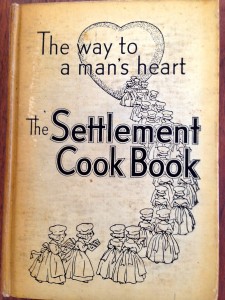
The Way to a Man’s Heart – the Settlement Cookbook compiled by Mrs. Simon Kander first appeared in 1901 as a source of funding for her Settlement House in Milwaukee.
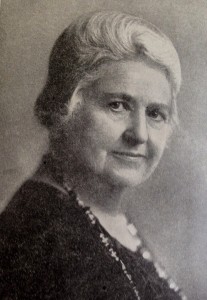
Mrs. Kander’s portrait appears next to the title page — just the thing to assure novice cooks they were in good hands.
Elizabeth Black Kander (1858-1940) was a Progressive who believed contemporary social decay could not be blamed solely on the effects of industrialization, urbanization, or capitalism, “but from the general willingness of women to escape personal responsibility.” By which she meant not home responsibility so much as municipal housekeeping. Kander believed women could and should use their natural housekeeping ability to manage the city. But not through voting, which she saw as an unproductive distraction from work that needed to be done.
Though Kander wasn’t directly responsible for the 1946 edition, the title page proclaimed all recipes had been tested in the Milwaukee Public School Kitchen.
Unusually, the index is in the front and sample menus at the back. All recipes were planned to serve 4-6 people, with formulas to produce sufficient food for 40 people. Special sections explain how to start a wood or coal fire stove, for those unfortunates who hadn’t upgraded to gas or electric ranges. Of the three books, only Kander’s devoted a section to feeding infants and very young children.
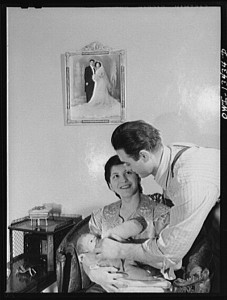
Substantial sections explain how to properly set the table for various formal and informal meals, how to serve when there is no maid, and how to clear the table and wash the dishes.
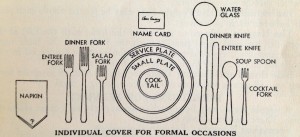
Kander also included lots of data. Did you know that one loaf of sandwich bread makes 24 sandwiches, or that a pound of butter will spread three loaves of bread?
Mrs. Kander covered just about everything, but it never hurts to have a second opinion. The second cook book on my mother’s shelf was The American Woman’s Cook Book, edited and revised by Ruth Berolzheimer, Director of the Culinary Arts Institute, first copyrighted in 1938. It was one of the first cookbooks to use four-color photography, and sold a million copies by 1943.
Teresa Ruth Berolzheimer (1886-1965) graduated from the University of Illinois at Champagne with a degree in chemical engineering, the second woman to do so. With her engineering degree, Berolzheimer became a social worker at the Abraham Lincoln House founded by Lizzie Black Kander. Small world.
Berolzheimer’s suggestions, however, are more upscale. One can almost hear her cluck as she points out “At one time it was the custom to serve long and elaborate dinners having many courses and much repetition of type foods. Gradually, the realization has grown that elaborate meals are not justified from any point of view, social, physiological, or economic, and that even the most formal meal must follow the rules of health.”
After which, she suggests menus for five-course meals.
APPETIZER
Canapés, fruit cocktail, or a clear soup
ENTREE
Meat, poultry or fish
SALAD
Anything light, refreshing, and crisp
DESSERT
Pastry, fruit or frozen dessert
COFFEE & LIQUEURS
Of course, there is also the question of where to consume coffee and liqueurs. Do we remain at the dining table or drift into another, more comfortable room? Berolzheimer advises:
“There is an increasing inclination to serve after-dinner coffee in the drawing room, living room or the library. The plan has many advantages. The original reason was to give guests more freedom and more luxury – dining room chairs are stiff at best. But in large families, young adults and children are eager to be excused—the former have their own plans and the latter have schoolwork to do, besides which they do not or should not drink coffee. The adults want to continue their discussions without interruption, while they have coffee, liqueurs and smokes at their leisure.
Besides, in many American homes, servants come in by the day or the hour. Serving coffee in the living room, in addition to the comfort it gives host and guests, allows maids to finish the cleaning up process…. In the maidless home, the dining-room doors can be closed, the lights turned out and both hostess and guests forget the work that awaits the former…. In many modern homes the dining room has disappeared, and its function taken over by an enlarged living room….There should be an appropriate screen to set around the table used for dining.”
You can almost hear the writer sigh how hard it was to find good “help” in 1946. Berolzheimer never married. Her nephew Henry later shared
“I thought she was kind of a lousy cook.”
Both these books are pretty straightforward. They tell the reader how to shop, cook, serve, and clean up a meal. They emphasize an attractive table to complement the food. And each has a compendium of recipes in every category. But they lack one important detail. Neither book explains how to prepare the food so everything is ready at the same time.
If the vegetables finish before the roast, for example, it’s likely the vegetables will be cold. What an embarrassment! Fortunately, Jean and Clarke Mattimore came to the rescue with their 1948 book Cooking by the Clock: Step by Step Preparation of Meals. Here were two people who understood the anxiety housewives faced trying to have a hot meal on the table when their husband got home.
“If you are making a dress or building a cabinet, directions tell you how to make each part and then assemble the component parts into the finished product. Cooking directions are different. You are told how to make one dish but now how to prepare and serve a complete meal. This book tells you how to put a complete meal on the table – everything coming out on time – with the hot dishes hot and the cold dishes cold.
If one of our recipes calls for a cream sauce or French dressing, you won’t have to refer to the index to find out how to make it. You will find complete directions – in logical sequence – with a clock to guide you.”
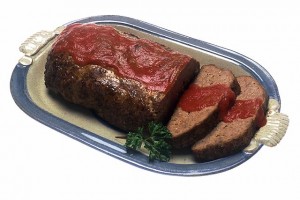
Menu 1 featured a basic dinner of meatloaf, French fried potatoes, buttered carrots, hot rolls, floating island pudding, and coffee served with the meal. The authors provide the shopping list and a list of utensils, bowls, and pans that will be used. Wind up the clock and away you go.
For an anticipated serving time of 6:30, start preparing the vegetables at 4:45. Prepare the meatloaf at 5:10. Twenty minutes later, with the meatloaf in the oven, prepare the floating island pudding. Half an hour later, put on the carrots and fry the potatoes. By 6:25, everything is done. Finish the coffee, put the meat and carrots on a serving platter, with the potatoes in a separate bowl. Whew! You made it.
Floating island pudding, by the way, is a custard of eggs, sugar, and milk requiring the use of a double boiler. Not sure I could cook it up in half an hour. I’m pretty sure my mother never tried.
Acknowledgments:
Featured Image: Hand Beater (often called an egg beater). Photo by Donovan Govan. Creative Commons Attribution. Wikimedia Commons.
____. “A Retro Cookbook.” The Old Foodie. Aug. 28, 2007. Here.
Ruth Berolzheimer. The American Woman’s Cook Book. Garden City: Garden City Publishing Co. Inc. 1947.
Mrs. Simon Kander. The Settlement Cook Book. Milwaukee: Settlement Cook Book Co., 1946.
Jean & Clarke Mattimore. Cooking by the Clock. NY: Farrar, Straus and Company. 1948.
Mike Sula. “Omnivorous: The Cookbook Queen.” Chicago Reader. Sept. 11, 2008. Here.
Some information taken from profiles in Wikipedia.

Sandra Wagner-Wright holds the doctoral degree in history and taught women’s and global history at the University of Hawai`i. Sandra travels for her research, most recently to Salem, Massachusetts, the setting of her new Salem Stories series. She also enjoys traveling for new experiences. Recent trips include Antarctica and a river cruise on the Rhine from Amsterdam to Basel.
Sandra particularly likes writing about strong women who make a difference. She lives in Hilo, Hawai`i with her family and writes a blog relating to history, travel, and the idiosyncrasies of life.


My mother relied on “Joy of Cooking” by Irma s. Rombauer first published in 1931. In addition to rabbit & squirrel there is bear, raccoon, muskrat, woodchuck, beaver, peccary, wild boar, & opossum. Re. ‘possum it says “If possible, trap ‘possum & feed it on milk & cereal for 10 days before killing it.” Today if I fed an animal for 10 days it would take on the status of “pet” and therefore not show up on my dinner table.
I tend to agree — although I don’t think I’d trap the animal in the first place. Too much of a city girl. Thanks for commenting.
No one is too old to learn! As a person who loves to cook, I find the article of yours very interesting. Gave me some tips I never thought of…(we all have our own style/way of doing things.) However, it’s kinda nice to know how the oldtimers of long ago did their thing! Many thanks for sharing. I first learned to cook from my Dad, then of course my Mom and even my grandmother! They all had their own style but I enjoyed watching and asked a lot of question….then I went my “merry way”..:) 🙂 🙂 Tnx..xoxoxodk
I agree, Dora. We watch, sometimes we read the recipe, and then we go our “merry way.” That’s why cooking is more art than science.